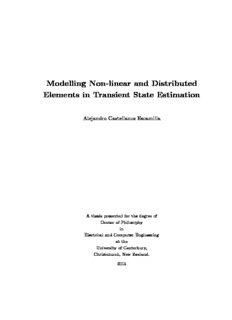
Castellanos, Alejandro PDF
Preview Castellanos, Alejandro
Modelling Non-linear and Distributed Elements in Transient State Estimation Alejandro Castellanos Escamilla A thesis presented for the degree of Doctor of Philosophy in Electrical and Computer Engineering at the University of Canterbury, Christchurch, New Zealand. 2015 ABSTRACT Power quality state estimation (PQSE) is a set of techniques with the objective to estimate diverse power quality phenomena in electric power systems; transient state estimation (TSE) being one such technique. Its objective is to estimate node voltage waveforms in a network after it has been subject to an electromagnetic transient. This work focuses on TSE using the numerical integrator substitution (NIS) method to model the system transients. The objective of this work is to further extend TSE with NIS, to include non-linear and distributed parameter elements. The intended application for TSE is to serve as an analysis tool for post-disturbance root cause analysis. Thetechniquecanbeconsideredunderdevelopmentbutinthefuturemustbecapable, considering certain requirements are met for measurements and system modelling, to help in the identification of the cause(s) for failure or malfunction when electromagnetic transients are recorded. The use of TSE removes the need of multiple simulation runs that are currently required in order to find the cause of disturbance (each simulation with a different system configuration trying to match measured waveforms). The contributions of this work include: analysis of numerical oscillation in TSE with NIS using single-phasecircuits, theapplication of TSEwith NISto non-linear branches usingthepiecewise linear method, the development of an extended observability analysis capable of identifying unobservableislands, the application of virtualmeasurements to linear and lumpedcircuits, and the application of TSE with NIS to transmission lines modelled with distributed parameters. ACKNOWLEDGEMENTS ThisworkwassupportedbyMexico’s National CouncilforScienceandTechnology (CONACyT) throughaPhDscholarship. Theauthorwould like tothank CONACyTfor its financialsupport. To my supervisor Professor Neville Watson; my infinite gratitude for his guidance, advice, and patience. To the people that enriched this experience, many of them my colleagues in the pursuit of a post-grad degree in electric power systems at Canterbury. Thank you for being there. The following is an extensive but certainly incomplete list: Bhaba Das, Zhiyang Jin, Kalyan Malla, Michael Hwang, Parash Achrya, Pat Bodger, Andrew Lapthorn, Edsel Villa, Ken Smart, Giang Dang, Lance Frater, Jorge Celis, Kelvin Gong, Harry Li, Yanosh Irani, Sheejan Pandey, Rabia Nazir, Eduardo Benitez Sandoval, Pablo Torres Lepe, Denise Arroyo Lambaer, Diwakar Brunel, Yiwei Hu, Yuheng Lu, Xueshu Cao, Josh Schipper, Jiaksan Tan, Rahman Peimankar, Patrick Chen, Ali Farzanehrafat, Steffen Fischer, Ming Zhong, and James Ormrod. GLOSSARY Abbreviations CT Current Transformer CVT Capacitor Voltage Transformer dB Decibel EMS Energy Management Systems EMTP ElectroMagnetic Transients Program GPS Global Positioning System IED Intelligent Electronic Device KCL Kirchhof’s Current Law NIS Numerical Integrator Substitution NRMSE Normalised Root Mean Square Error PQSE Power Quality State Estimation RMS Root Mean Square SCADA Supervisory Control And Data Acquisition SNR Signal-to-Noise Ratio SVD Singular Value Decomposition TSE Transient State Estimation viii GLOSSARY Nomenclature z Measurements vector H Measurements matrix x State variables vector w Measurement’s Gaussian white noise G Gain matrix HT Transpose of matrix H H 1 Inverse of matrix H − det(H) Determinant of matrix H rank(H) Rank of matrix H null(H) Nullity of matrix H v Voltage at node k k i Current flow in branch jk, positive direction from j to k jk R Resistance L Inductance C Capacitance t Time d Ordinary derivative dt ∆t Time interval magnitude or time-step b f(t)dt Definite integral a R v Discrete voltage at node k at time t k(t) ∂ Partial derivative ∂t ′ R Resistance per unit length Z Characteristic impedance, transmission line c ν Wave phase velocity, transmission line τ Wave travelling time, transmission line Y Equivalent conductance matrix U Right eigenvectors matrix, SVD V Left eigenvectors matrix, SVD S Singular values diagonal matrix, SVD H+ Pseudo-inverse of matrix H σ Standard deviation σ2 Variance A Signal amplitude, peak value PEAKsignal A Signal amplitude, RMS value RMSsignal CONTENTS ABSTRACT iii ACKNOWLEDGEMENTS v GLOSSARY vii LIST OF FIGURES xiii LIST OF TABLES xv CHAPTER 1 INTRODUCTION 1 1.1 General overview 1 1.2 Objectives 2 1.3 Contributions 2 1.4 Thesis layout 3 CHAPTER 2 BACKGROUND 5 2.1 Power quality state estimation 5 2.1.1 Power systems steady-state estimation 6 2.1.2 Harmonic state estimation 11 2.1.3 Voltage sag/dip state estimation 13 2.1.4 Transient state estimation 14 2.2 Numerical integrator substitution method 16 2.2.1 Lumped parameters 16 2.2.2 Distributed parameters 19 2.3 TSE with NIS 22 2.3.1 Problem formulation 22 2.3.2 SVD solution 23 2.4 Conclusion 26 CHAPTER 3 NUMERICAL OSCILLATIONS, AND NON-LINEAR ELEMENTS 27 3.1 Noise, numerical oscillations, and chatter in TSE 27 3.1.1 Noise definition and simulation 27 3.1.2 Numerical oscillations 30 3.2 Linear interpolation 35 x CONTENTS 3.2.1 Application example 36 3.3 Non-linear elements 39 3.3.1 Non-linear resistors (piecewise method) 39 3.3.2 Non-linear inductors 42 3.4 Conclusion 44 CHAPTER 4 OBSERVABILITY AND VIRTUAL MEASUREMENTS 45 4.1 Observability analysis 45 4.1.1 Partial observability 45 4.1.2 Observability analysis using SVD 46 4.1.3 Identification of unobservable islands 50 4.1.4 Improved observability analysis procedure 52 4.2 Virtual measurements 54 4.2.1 Application examples 56 4.3 Conclusion 60 CHAPTER 5 DISTRIBUTED PARAMETERS 61 5.1 Transmission line modelling with NIS 61 5.1.1 Bergeron model with losses 62 5.2 Inclusion of distributed parameter lines in TSE 63 5.3 Estimation solution 64 5.3.1 Initial condition 64 5.3.2 Travelling time interpolation 66 5.4 Observability 66 5.5 Application examples 66 5.5.1 Test system 1 68 5.5.2 Test system 2 73 5.6 Conclusion 78 CHAPTER 6 CONCLUSION 79 6.1 Conclusion 79 6.2 Future work 80 APPENDIX ANORMALISED ROOT MEAN SQUARE ERROR 83 APPENDIX B KILLINCHY DISTRIBUTION SYSTEM DATA 85 APPENDIX C PHASOR ESTIMATION BY LEAST-SQUARES 87 APPENDIX DLIST OF PUBLICATIONS 89 REFERENCES 91
Description: